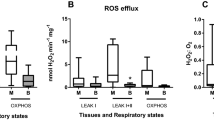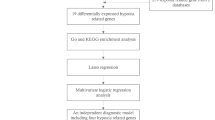Abstract
Background:
Supplemental oxygen used during resuscitation can be detrimental to the newborn brain. The aim was to determine how different oxygen therapies affect gene transcription in a hypoxia–reoxygenation model.
Methods:
C57BL/6 mice (n = 56), postnatal day 7, were randomized either to 120 min of hypoxia 8% O2 followed by 30 min of reoxygenation with 21, 40, 60, or 100% O2, or to normoxia followed by 30 min of 21 or 100% O2. Affymetrix 750k expression array was applied with RT-PCR used for validation. Histopathology and immunohistochemistry 3 d after hypoxia–reoxygenation compared groups reoxygenated with 21 or 100% O2 with normoxic controls (n = 22).
Results:
In total, ~81% of the gene expression changes were altered in response to reoxygenation with 60 or 100% O2 and constituted many inflammatory-responsive genes (i.e., C5ar2, Stat3, and Ccl12). Oxidative phosphorylation was downregulated after 60 or 100% O2. Iba1+ cells were significantly increased in the striatum and hippocampal CA1 after both 21 and 100% O2.
Conclusion:
In the present model, hypoxia–reoxygenation induces microglial accumulation in subregions of the brain. The transcriptional changes dominating after applying hyperoxic reoxygenation regimes include upregulating genes related to inflammatory responses and suppressing the oxidative phosphorylation pathway.
Similar content being viewed by others
Log in or create a free account to read this content
Gain free access to this article, as well as selected content from this journal and more on nature.com
or
References
Boschi-Pinto C, Young M, Black RE . The Child Health Epidemiology Reference Group reviews of the effectiveness of interventions to reduce maternal, neonatal and child mortality. Int J Epidemiol 2010;39:Suppl 1:i3–6.
Vannucci RC, Yager JY, Vannucci SJ . Cerebral glucose and energy utilization during the evolution of hypoxic-ischemic brain damage in the immature rat. J Cereb Blood Flow Metab 1994;14:279–88.
Ferriero DM . Neonatal brain injury. N Engl J Med 2004;351:1985–95.
McQuillen PS, Ferriero DM . Selective vulnerability in the developing central nervous system. Pediatr Neurol 2004;30:227–35.
Vexler ZS, Tang XN, Yenari MA . Inflammation in adult and neonatal stroke. Clin Neurosci Res 2006;6:293–313.
Vexler ZS, Yenari MA . Does inflammation after stroke affect the developing brain differently than adult brain? Dev Neurosci 2009;31:378–93.
Markus T, Hansson S, Amer-Wåhlin I, Hellström-Westas L, Saugstad OD, Ley D . Cerebral inflammatory response after fetal asphyxia and hyperoxic resuscitation in newborn sheep. Pediatr Res 2007;62:71–7.
Munkeby BH, Børke WB, Bjørnland K, et al. Resuscitation with 100% O2 increases cerebral injury in hypoxemic piglets. Pediatr Res 2004;56:783–90.
Solberg R, Løberg EM, Andresen JH, et al. Resuscitation of newborn piglets. short-term influence of FiO2 on matrix metalloproteinases, caspase-3 and BDNF. PLoS ONE 2010;5:e14261.
Gill MB, Bockhorst K, Narayana P, Perez-Polo JR . Bax shuttling after neonatal hypoxia-ischemia: hyperoxia effects. J Neurosci Res 2008;86:3584–604.
Ramji S, Ahuja S, Thirupuram S, Rootwelt T, Rooth G, Saugstad OD . Resuscitation of asphyxic newborn infants with room air or 100% oxygen. Pediatr Res 1993;34:809–12.
Saugstad OD, Ramji S, Irani SF, et al. Resuscitation of newborn infants with 21% or 100% oxygen: follow-up at 18 to 24 months. Pediatrics 2003;112:296–300.
Tan A, Schulze A, O’Donnell CP, Davis PG . Air versus oxygen for resuscitation of infants at birth. Cochrane Database Syst Rev 2005;<Volume>:CD002273.
Perlman JM, Wyllie J, Kattwinkel J, et al.; Neonatal Resuscitation Chapter Collaborators. Part 11: Neonatal resuscitation: 2010 International Consensus on Cardiopulmonary Resuscitation and Emergency Cardiovascular Care Science With Treatment Recommendations. Circulation 2010;122(Suppl 2):S516–38.
Raju TN, Higgins RD, Stark AR, Leveno KJ . Optimizing care and outcome for late-preterm (near-term) infants: a summary of the workshop sponsored by the National Institute of Child Health and Human Development. Pediatrics 2006;118:1207–14.
Hagberg H, Peebles D, Mallard C . Models of white matter injury: comparison of infectious, hypoxic-ischemic, and excitotoxic insults. Ment Retard Dev Disabil Res Rev 2002;8:30–8.
Wollen EJ, Sejersted Y, Wright MS, et al. Transcriptome profiling of the newborn mouse lung after hypoxia and reoxygenation: hyperoxic reoxygenation affects mTOR signaling pathway, DNA repair, and JNK-pathway regulation. Pediatr Res 2013;74:536–44.
Low JA . Intrapartum fetal asphyxia: definition, diagnosis, and classification. Am J Obstet Gynecol 1997;176:957–9.
Sejersted Y, Aasland AL, Bjørås M, Eide L, Saugstad OD . Accumulation of 8-oxoguanine in liver DNA during hyperoxic resuscitation of newborn mice. Pediatr Res 2009;66:533–8.
Kofler J, Otsuka T, Zhang Z, et al. Differential effect of PARP-2 deletion on brain injury after focal and global cerebral ischemia. J Cereb Blood Flow Metab 2006;26:135–41.
Solberg R, Longini M, Proietti F, Vezzosi P, Saugstad OD, Buonocore G . Resuscitation with supplementary oxygen induces oxidative injury in the cerebral cortex. Free Radic Biol Med 2012;53:1061–7.
Sharp FR, Ran R, Lu A, et al. Hypoxic preconditioning protects against ischemic brain injury. NeuroRx 2004;1:26–35.
Ezquer ME, Valdez SR, Seltzer AM . Inflammatory responses of the substantia nigra after acute hypoxia in neonatal rats. Exp Neurol 2006;197:391–8.
Weber A, Dzietko M, Berns M, et al. Neuronal damage after moderate hypoxia and erythropoietin. Neurobiol Dis 2005;20:594–600.
Dalen ML, Liu X, Elstad M, et al. Resuscitation with 100% oxygen increases injury and counteracts the neuroprotective effect of therapeutic hypothermia in the neonatal rat. Pediatr Res 2012;71:247–52.
Felderhoff-Mueser U, Bittigau P, Sifringer M, et al. Oxygen causes cell death in the developing brain. Neurobiol Dis 2004;17:273–82.
Hazelton JL, Balan I, Elmer GI, et al. Hyperoxic reperfusion after global cerebral ischemia promotes inflammation and long-term hippocampal neuronal death. J Neurotrauma 2010;27:753–62.
Sejersted Y, Hildrestrand GA, Kunke D, et al. Endonuclease VIII-like 3 (Neil3) DNA glycosylase promotes neurogenesis induced by hypoxia-ischemia. Proc Natl Acad Sci USA 2011;108:18802–7.
Carson MJ, Sutcliffe JG . Balancing function vs. self defense: the CNS as an active regulator of immune responses. J Neurosci Res 1999;55:1–8.
Heidecker B, Kasper EK, Wittstein IS, et al. Transcriptomic biomarkers for individual risk assessment in new-onset heart failure. Circulation 2008;118:238–46.
Gustavsson M, Wilson MA, Mallard C, Rousset C, Johnston MV, Hagberg H . Global gene expression in the developing rat brain after hypoxic preconditioning: involvement of apoptotic mechanisms? Pediatr Res 2007;61:444–50.
Hedtjärn M, Mallard C, Hagberg H . Inflammatory gene profiling in the developing mouse brain after hypoxia-ischemia. J Cereb Blood Flow Metab 2004;24:1333–51.
Richards EM, Fiskum G, Rosenthal RE, Hopkins I, McKenna MC . Hyperoxic reperfusion after global ischemia decreases hippocampal energy metabolism. Stroke 2007;38:1578–84.
Solberg R, Enot D, Deigner HP, et al. Metabolomic analyses of plasma reveals new insights into asphyxia and resuscitation in pigs. PLoS ONE 2010;5:e9606.
Cha YK, Kim YH, Ahn YH, Koh JY . Epidermal growth factor induces oxidative neuronal injury in cortical culture. J Neurochem 2000;75:298–303.
Yu X, Guo J, Fang H, Peng S . Basal metallothionein-I/II protects against NMDA-mediated oxidative injury in cortical neuron/astrocyte cultures. Toxicology 2011;282:16–22.
Randerath E, Zhou GD, Randerath K . Organ-specific oxidative DNA damage associated with normal birth in rats. Carcinogenesis 1997;18:859–66.
Huen MS, Chen J . The DNA damage response pathways: at the crossroad of protein modifications. Cell Res 2008;18:8–16.
Acknowledgements
We express gratitude to Monica Atneosen-Aasegg and Grethe Dyrhaug for their assistance during the animal experiments and RT-PCR. We thank Jonas Øgaard and Grethe Dyrhaug for valuable contribution in the immunohistological analysis. The animal experiments were performed at Centre of Comparative Medicine, Oslo University Hospital, Rikshospitalet, and we appreciate the help and facilities that we were offered during our work.
Author information
Authors and Affiliations
Corresponding author
Supplementary information
Supplementary Table S1.
(DOC 37 kb)
Supplementary Table S2.
(DOC 222 kb)
Supplementary Table S3.
(DOC 115 kb)
Supplementary Table S4.
(DOC 103 kb)
Supplementary Table S5.
(DOC 158 kb)
Supplementary Table S6.
(DOC 621 kb)
Supplementary Table S7.
(DOC 41 kb)
Supplementary Methods
(DOC 32 kb)
Rights and permissions
About this article
Cite this article
Wollen, E., Sejersted, Y., Wright, M. et al. Transcriptome profiling of the newborn mouse brain after hypoxia–reoxygenation: hyperoxic reoxygenation induces inflammatory and energy failure responsive genes. Pediatr Res 75, 517–526 (2014). https://doi.org/10.1038/pr.2013.249
Received:
Accepted:
Published:
Issue date:
DOI: https://doi.org/10.1038/pr.2013.249
This article is cited by
-
Neonatal chest compressions: time to act
Pediatric Research (2021)
-
Retinopathy of prematurity: inflammation, choroidal degeneration, and novel promising therapeutic strategies
Journal of Neuroinflammation (2017)
-
Cardiopulmonary bypass in the newborn: effects of circulatory cell-free hemoglobin and hyperoxia evaluated in a novel rat pup model
Intensive Care Medicine Experimental (2017)
-
Short-term effects of cannabidiol after global hypoxia-ischemia in newborn piglets
Pediatric Research (2016)
-
Increased expression of inflammatory genes in the neonatal mouse brain after hyperoxic reoxygenation
Pediatric Research (2015)



